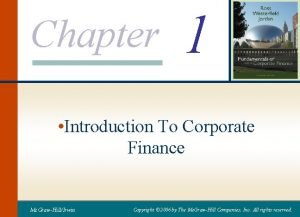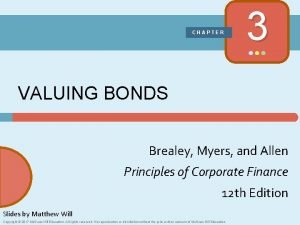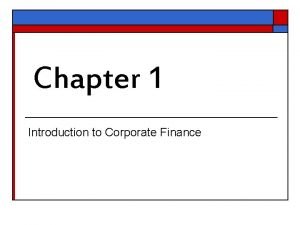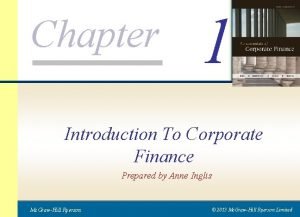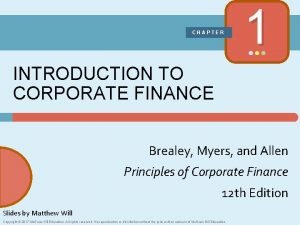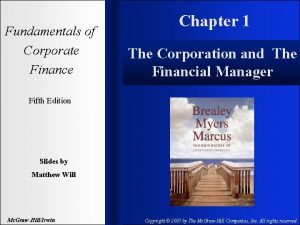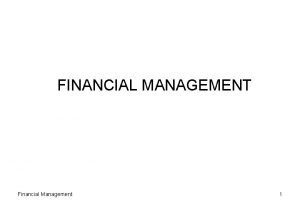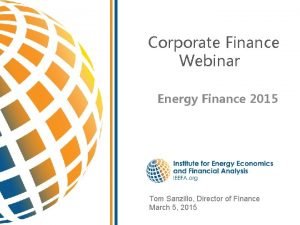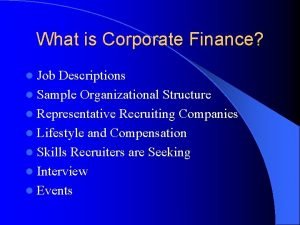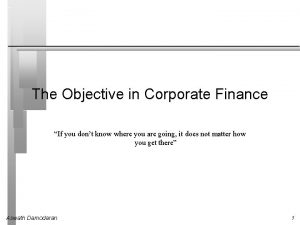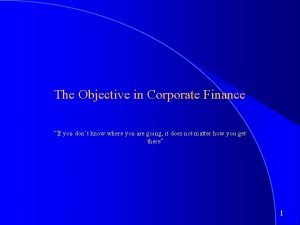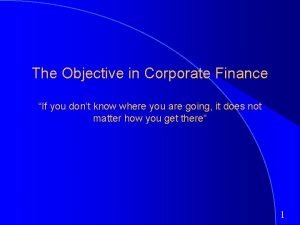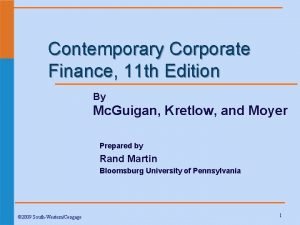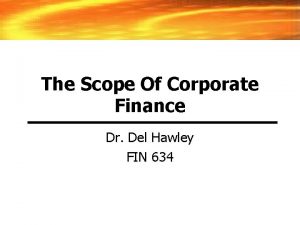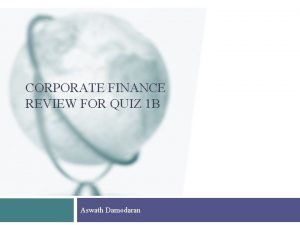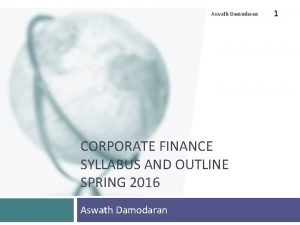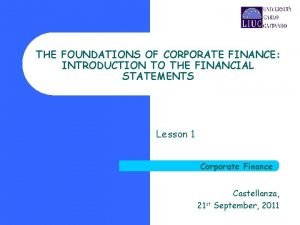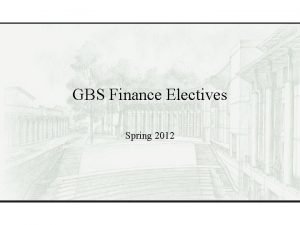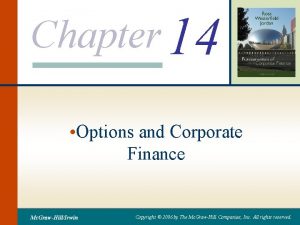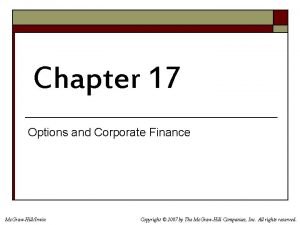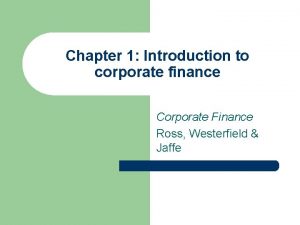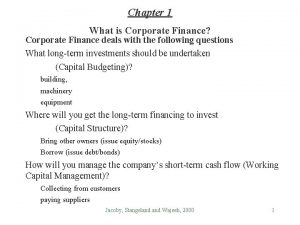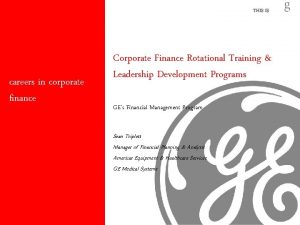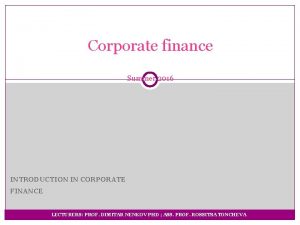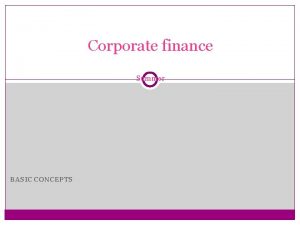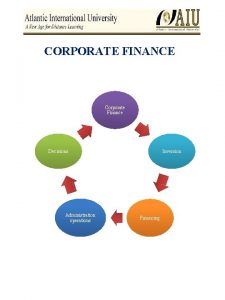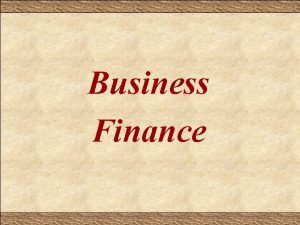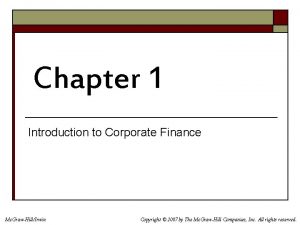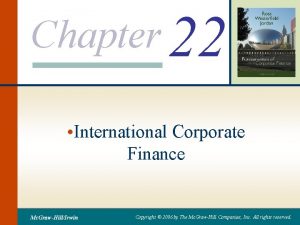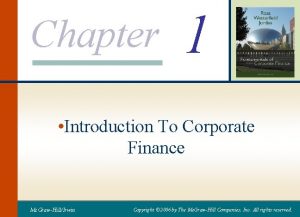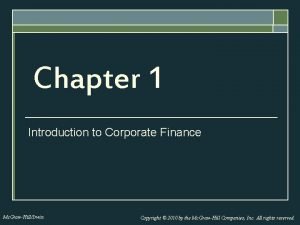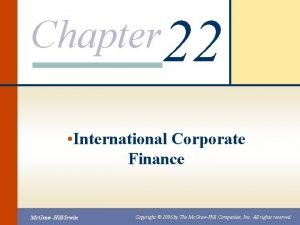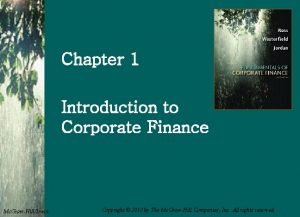Chapter 14 Options and Corporate Finance Mc GrawHillIrwin


























- Slides: 26

Chapter 14 • Options and Corporate Finance Mc. Graw-Hill/Irwin Copyright © 2006 by The Mc. Graw-Hill Companies, Inc. All rights reserved.

Key Concepts and Skills • Understand the options terminology • Be able to determine option payoffs and pricing bounds • Understand the five major determinants of option value • Understand employee stock options • Understand the various managerial options • Understand the differences between warrants and traditional call options • Understand convertible securities and how to determine their value 1

Chapter Outline • • Options: The Basics Fundamentals of Option Valuation Valuing a Call Option Employee Stock Options Equity as a Call Option on the Firm’s Assets Options and Capital Budgeting Options and Corporate Securities 2

Option Terminology • • Call Put Strike or Exercise price Expiration date Option premium Option writer American Option European Option 3

Stock Option Quotations • Look at Table 14. 1 in the book • Price and volume information for calls and puts with the same strike and expiration is provided on the same line • Things to notice • Prices are higher for options with the same strike price but longer expirations • Call options with strikes less than the current price are worth more than the corresponding puts • Call options with strikes greater than the current price are worth less than the corresponding puts 4

Option Payoffs – Calls • The value of the call at expiration is the intrinsic value • Max(0, S-E) • If S<E, then the payoff is 0 • If S>E, then the payoff is S – E • Assume that the exercise price is $30 5

Option Payoffs - Puts • The value of a put at expiration is the intrinsic value • Max(0, E-S) • If S<E, then the payoff is E-S • If S>E, then the payoff is 0 • Assume that the exercise price is $30 6

Work the Web Example • Where can we find option prices? • On the Internet, of course. One site that provides option prices is Yahoo Finance • Click on the web surfer to go to Yahoo Finance • Enter a ticker symbol to get a basic quote • Follow the options link • Check out “symbology” to see how the ticker symbols are formed 7

Call Option Bounds • Upper bound • Call price must be less than or equal to the stock price • Lower bound • Call price must be greater than or equal to the stock price minus the exercise price or zero, whichever is greater • If either of these bounds are violated, there is an arbitrage opportunity 8

Figure 14. 2 9

A Simple Model • An option is “in-the-money” if the payoff is greater than zero • If a call option is sure to finish in-themoney, the option value would be • C 0 = S 0 – PV(E) • If the call is worth something other than this, then there is an arbitrage opportunity 10

What Determines Option Values? • Stock price • As the stock price increases, the call price increases and the put price decreases • Exercise price • As the exercise price increases, the call price decreases and the put price increases • Time to expiration • Generally, as the time to expiration increases both the call and the put prices increase • Risk-free rate • As the risk-free rate increases, the call price increases and the put price decreases 11

What about Variance? • When an option may finish out-of-the-money (expire without being exercised), there is another factor that helps determine price • The variance in underlying asset returns is a less obvious, but important, determinant of option values • The greater the variance, the more the call and the put are worth • If an option finishes out-of-the-money, the most you can lose is your premium, no matter how far out it is • The more an option is in-the-money, the greater the gain • The owner of the option gains from volatility on the upside, but don’t lose anymore from volatility on the downside 12

Table 14. 2 13

Employee Stock Options • Options that are given to employees as part of their benefits package • Often used as a bonus or incentive • Designed to align employee interests with stockholder interests and reduce agency problems • Empirical evidence suggests that they don’t work as well as anticipated due to the lack of diversification introduced into the employees’ portfolios • The stock isn’t worth as much to the employee as it is to an outside investor because of the lack of diversification – this suggests that options may work in limited amounts, but not as a large part of the compensation package 14

Equity: A Call Option • Equity can be viewed as a call option on the company’s assets when the firm is leveraged • The exercise price is the face value of the debt • If the assets are worth more than the debt when it comes due, the option will be exercised and the stockholders retain ownership • If the assets are worth less than the debt, the stockholders will let the option expire and the assets will belong to the bondholders 15

Capital Budgeting Options • Almost all capital budgeting scenarios contain implicit options • Because options are valuable, they make the capital budgeting project worth more than it may appear • Failure to account for these options can cause firms to reject good projects 16

Timing Options • We normally assume that a project must be taken today or forgone completely • Almost all projects have the embedded option to wait • A good project may be worth more if we wait • A seemingly bad project may actually have a positive NPV if we wait due to changing economic conditions • We should examine the NPV of taking an investment now, or in future years, and plan to invest at the time that the project produces the highest NPV 17

Example: Timing Options • Consider a project that costs $5000 and has an expected future cash flow of $700 per year forever. If we wait one year, the cost will increase to $5500 and the expected future cash flow will increase to $800. If the required return is 13%, should we accept the project? If so, when should we begin? • NPV starting today = -5000 + 700/. 13 = 384. 62 • NPV waiting one year = (-5500 + 800/. 13)/(1. 13) = 578. 62 • It is a good project either way, but we should wait until next year 18

Managerial Options • Managers often have options after a project has been implemented that can add value • It is important to do some contingency planning ahead of time to determine what will cause the options to be exercised • Some examples include • The option to expand a project if it goes well • The option to abandon a project if it goes poorly • The option to suspend or contract operations particularly in the manufacturing industries • Strategic options – look at how taking this project opens up other opportunities that would be otherwise unavailable 19

Warrants • A call option issued by corporations in conjunction with other securities to reduce the yield required on the other securities • Differences between warrants and traditional call options • Warrants are generally very long term • They are written by the company and exercise results in additional shares outstanding • The exercise price is paid to the company, generates cash for the firm and alters the capital structure • Warrants can normally be detached from the original securities and sold separately • Exercise of warrants reduces EPS, so warrants are included when a firm reports “diluted EPS” 20

Convertibles • Convertible bonds (or preferred stock) may be converted into a specified number of common shares at the option of the bondholder • The conversion price is the effective price paid for the stock • The conversion ratio is the number of shares received when the bond is converted • Convertible bonds will be worth at least as much as the straight bond value or the conversion value, whichever is greater 21

Valuing Convertibles • Suppose you have a 10% bond that pays semiannual coupons and will mature in 15 years. The face value is $1000 and the yield to maturity on similar bonds is 9%. The bond is also convertible with a conversion price of $100. The stock is currently selling for $110. What is the minimum price of the bond? • • Straight bond value = 1081. 44 Conversion ratio = 1000/100 = 10 Conversion value = 10*110 = 1100 Minimum price = $1100 22

Other Options • Call provision on a bond • Allows the company to repurchase the bond prior to maturity at a specified price that is generally higher than the face value • Increases the required yield on the bond – this is effectively how the company pays for the option • Put bond • Allows the bondholder to require the company to repurchase the bond prior to maturity at a fixed price • Insurance and Loan Guarantees • These are essentially put options 23

Quick Quiz • What is the difference between a call option and a put option? • What is the intrinsic value of call and put options and what do the payoff diagrams look like? • What are the five major determinants of option prices and their relationships to option prices? • What are some of the major capital budgeting options? • How would you value a convertible bond? 24

Chapter 14 • End of Chapter Mc. Graw-Hill/Irwin Copyright © 2006 by The Mc. Graw-Hill Companies, Inc. All rights reserved.
 Corporate finance objectives
Corporate finance objectives Fundamentals of corporate finance chapter 6 solutions
Fundamentals of corporate finance chapter 6 solutions Introduction to corporate finance
Introduction to corporate finance Fundamentals of corporate finance chapter 1
Fundamentals of corporate finance chapter 1 Principles of corporate finance chapter 3 solutions
Principles of corporate finance chapter 3 solutions Corporate finance chapter 1
Corporate finance chapter 1 Chapter 1 introduction to corporate finance
Chapter 1 introduction to corporate finance Chapter 1 introduction to corporate finance
Chapter 1 introduction to corporate finance Fundamentals of corporate finance, chapter 1
Fundamentals of corporate finance, chapter 1 Financial theory of investment
Financial theory of investment Corporate finance webinar
Corporate finance webinar Investment banking activities
Investment banking activities Corporate finance job scope
Corporate finance job scope Objective of corporate finance
Objective of corporate finance Objectives of corporate finance
Objectives of corporate finance Objective of corporate finance
Objective of corporate finance Strategic corporate finance maastricht
Strategic corporate finance maastricht Contemporary corporate finance
Contemporary corporate finance Scope of corporate finance
Scope of corporate finance Objective of corporate governance
Objective of corporate governance Sujata madan
Sujata madan Damodaran beta
Damodaran beta Corporate finance law firm hong kong
Corporate finance law firm hong kong Corporate finance tenth edition
Corporate finance tenth edition Corporate finance syllabus
Corporate finance syllabus Foundations of corporate finance
Foundations of corporate finance Gbs corporate finance
Gbs corporate finance


